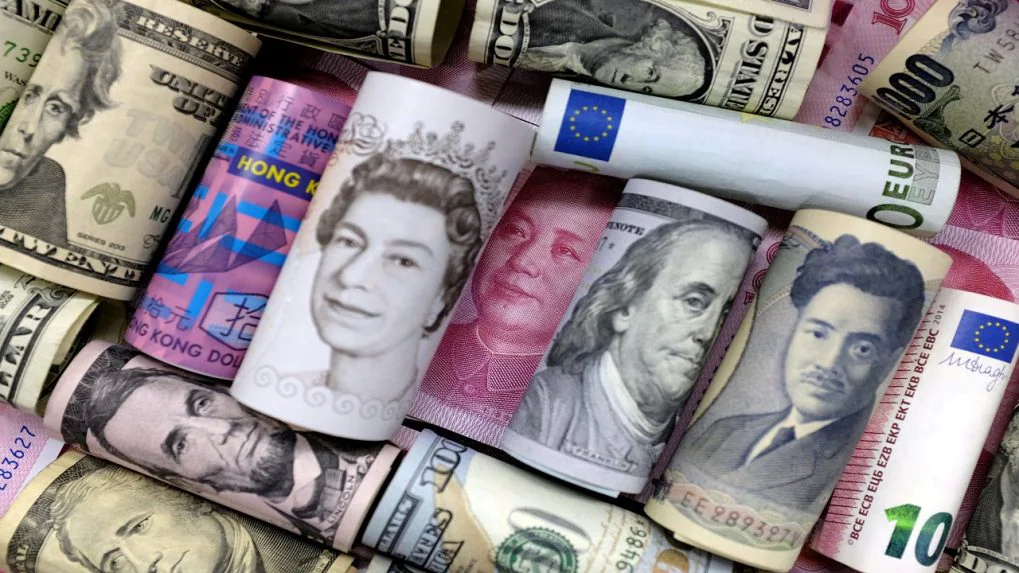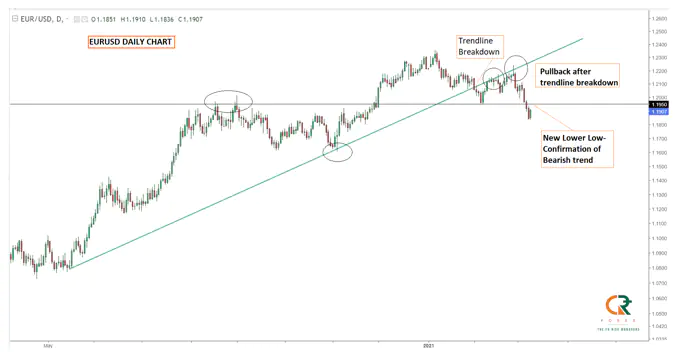- March 10, 2021
- Posted by: Amit Pabari
- Category: Currency

After a long sustained rally that picked up pace in March 2020 has somewhere come to a halt and EURO seems to have to reverse its trend. Over the period of last 12 months, EURO had risen nearly over 15 percent from 1.0650 to 1.23000 levels before going sideways and now giving a bearish signal. Looking at the fundamentals, technical and price action for the pair, it seems like bears have taken control over the bulls and the euro-dollar can hit bottom close to 1.1650 levels in the medium term. This is suggested by the below-mentioned reasoning:
Fundamentals:
ECB stance on rising yields: The European Central Bank’s rate decision in the upcoming meeting is likely to be ultra-dovish, with ECB officials expressing discomfort with the rise in Eurozone yields in no uncertain terms. Overall, policymakers could step up the pace of asset purchases to counter rising bond yields, which could further hurt growth prospects. That will certainly place more pressure on the euro-dollar pair.
Gloomy Data: Data-wise, European figures seem worrisome as preventive lockdowns continue in the Euro-Zone, with some countries extending them till April. Two particular macroeconomic figures were alarming; retail sales plummeted in Germany and the Euro Zone, while the services sector remained in contraction territory in February. Additionally, inflation in Germany picked up, but that of the euro area remained subdued.
On the contrary, in the US, Manufacturing and Service PMIs remained in expansion territory for consecutive two months and the recent surge in Nonfarm Employment Change, which shined with a reading of 397,000, was the cherry on the cake. Gloomy Euro-zone economic outlook coupled with robust US economic indicators put downward pressure on the EURO.
Crawling Vaccine Rollout: Slow progress in Covid-19 immunization in the EU and extensive lockdowns adds to the gloom perspective. With America now expected to reach 50 percent of its population by late May, the US has continued enlarging its gap from Europe in terms of vaccination. European Commission President Ursula acknowledged the EU’s vaccine rollout failures claiming they were late to authorise and what they ordered was not delivered on time.
Overall, UK has been the most successful in providing vaccine doses and has given nearly 32.3 per 100, US following with 24.3 per 100 doses and EU lagging by just 8.1 doses per 100. The faster the vaccine rollout, the stronger the recovery and stronger the currency has been the new market theory. This has been playing well with USD and GBP and contrasting to EUR.
CFTC Positioning: In the past one-month CFTC EUR speculative net positions on the buy-side have been seen declining on a week-on-week basis. It has fallen from 1,65,000 in the first week of February to 1,26,000 currently. This decline indicates that the sentiments of speculators and traders are turning bearish for the EUR and the long positions are sustainably descending, thereby hinting at further weakness in the EUR.
Surging Dollar: US Treasuries have suffered a sell-off on expectations of more robust growth and ignorance by the Fed to intervene by buying bonds and pushing long-term borrowing costs lower. Since then, the Dollar received two additional shots, the first was a boost to growth prospects and another came from the Senate, which approved a modified version of President Joe Biden’s coronavirus relief package.
Broadly, there is a disagreement whether yields are rising as a result of inflation fears coming from more stimulus, or over-optimism about how more stimulus is going to boost the long-term economic outlook. Either way seems to be boding well for the dollar index; if it is the former, that means tighter Fed policy. If it is the latter, that means a combination of even greater US economic outperformance than might already be priced in and tighter Fed policy. All in all, the dollar looks to be shooting high either way thereby pressuring the EUR.
Technical Aspect:
As the above chart indicates, there is a breakdown in the uptrend of EURUSD. Post the breakdown, the pair has tested the trend line by giving a pullback close to 1.22 levels and followed by a new lower low formation below 1.19 level. This has given a confirmation of the resumption of the bearish trend in the major which could extend close to 1.1650 levels.
Strategy:
Exporters: Exporters having an option of booking in two legs can book euro-dollar on upticks between 1.1950-1.20 levels and book dollar-rupee on upticks close to 73.50-74.00 levels as seen. For a single leg, one can cover on upticks close to 87.20-87.50 levels. Overall, a hedge ratio of 60 percent to 70 percent is advisable
Importers: For once booking in two legs can book dollar-rupee below 73.00 levels and euro-dollar can be kept open and could be targeted to cover around 1.1650-1.1700 levels. For once booking in single are suggested holding and participating on dips close to 85.80-86.20 levels for the near term exposures.
-Amit Pabari is managing director of CR Forex Advisors. The views expressed are personal.
Leave a Reply
You must be logged in to post a comment.





